Kia kori tahi
Physical wellbeing in early learning
This is a suite of resources designed to support the physical wellbeing of tamariki.
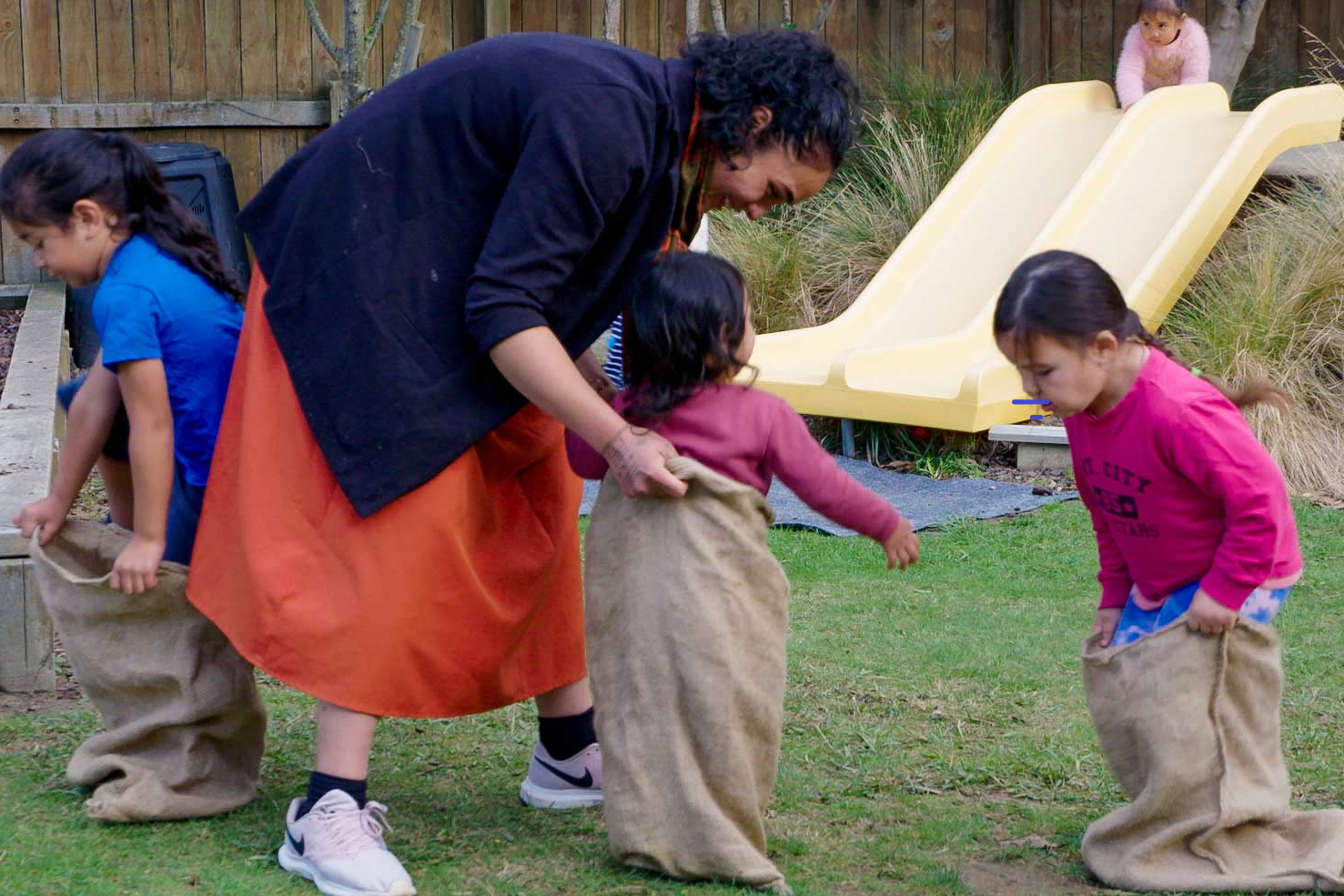
Kia kori tahi is a suite of resources designed to support the physical wellbeing of tamariki. They have a focus on active movement. Movement primes the brain for learning, fostering the neural pathways that form the foundations for hinengaro (cognitive), tinana (physical), whatumanawa) (emotional), and wairua (spiritual) learning.
These resources support kaiako to consider the ways in which they currently support the physical wellbeing of tamariki and how that learning is occurring. They encourage kaiako to reflect on how they could further enhance teaching practices and learning outcomes.
The resources are aligned to the concepts and approaches that underpin the He Māpuna te Tamaiti resources, which support social and emotional competence in early learning.
Videos
These videos show tamariki learning to move, develop, and express themselves physically. They start with a child's voice and draw on the child's questions. Using this voice and these questions is intended to challenge kaiako to reflect on the way they follow the child's lead.
Do you let me fly?
Do you hear me?
These information sheets expand on the ideas in the above videos. They provide additional information on fundamental movement skills and rhythmic movement. Kaiako can use this information to develop intentional teaching strategies to support the physical wellbeing of tamariki.
See Materials that come with this resource to download:
- Kia kori tahi – Fundamental movement skills (.pdf)
- Kia kori tahi – Rhythmic movement (.pdf)
A holistic approach to hauora: Lessons from Tāne Mahuta
Key points
- Our hauora, our health and wellbeing, is holistic – it is physical, emotional, cognitive, and spiritual
- Pūrākau and atua teach us to be kaitiaki of the physical world and our own health and wellbeing
Nestled into the hills of Wainuiomata, surrounded by bush sits Whānau Treehouse, a privately owned puna reo catering for children from zero to five years old. Kaiako have embedded a kaupapa Māori approach to curriculum design and use a Māui assessment framework.
For these kaiako, hauora, health and wellbeing, is holistic. Hauora is about physical and spiritual connections to place and atua. This is evident in the ways kaiako and whānau routinely acknowledge mana whenua. As part of their professional learning, kaiako visit sites of significance to experience the pūrākau of the rohe. These local pūrākau, karakia, and waiata are threaded through the lived curriculum and experienced by tamariki, whānau, and kaiako alike. Kaiako use them with tamariki to explore hauora for themselves and for the natural world. Self-care, caring for others, and caring for the physical world are interwoven into their programme.
A significant part of their programme centres around daily visits to ngahere, the bush. Rain or shine, tamariki head into the bush. Every visit starts with a karakia before tamariki, whānau, and kaiako venture along the tracks, winding beside a shallow stream and disappearing enticingly up hillsides. Tamariki are encouraged to listen, to watch, and to tread gently as they explore. Following their matua lead, they ask for permission from Tāne Mahuta before they pick up leaves, and, unprompted, say a short karakia to express their respect and appreciation for the life found in ngahere.
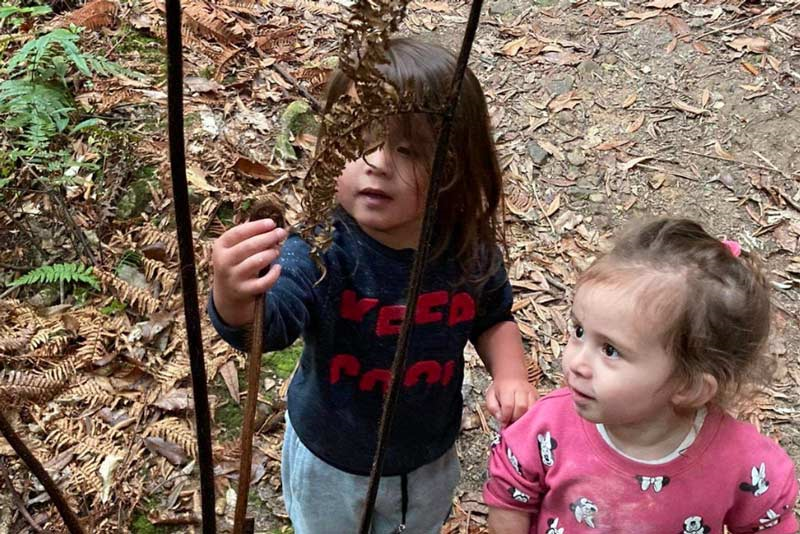
Kaiako talk about Tāne Mahuta on their walks and regularly remind tamariki about how he teaches them to look after Papatūānuku. When they share the pūrākau about how Ranginui and Papatūānuku were separated, and how ngahere came into being, they’ve seen tamariki lie down on the ground pretending to be Tāne and pushing their legs towards the sky. Tamariki are encouraged to embody the physical experience of feeling connected to Papatūānuku.
An important element of the Whānau Treehouse curriculum is respect for the physical world and the opportunities for play it offers. Tamariki are free to explore their physical capabilities: testing their stability by walking and running on uneven and, at times, slippery ground; using rocks as stepping stones across small streams and balancing on fallen logs. Tamariki thrive on the gross motor challenges of climbing trees, sliding down slippery slopes, and winding their way up steep banks. Kaiako have noticed how they express gratitude to Tāne for the tree roots to grab as they clamber and scramble along natural tracks under the canopy.
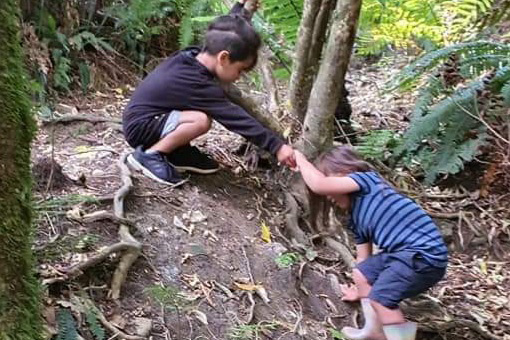
Kaiako are mindful of the risks and keep a watchful eye on tamariki as they create their own obstacle courses.
Back at the centre, tamariki practise balancing on the planks and ladders available in the outdoor area, refining and perfecting control over their bodies.
The daily walks into ngahere support hauora. Tamariki, whānau, and kaiako:
- understand that the physical world has spiritual dimensions
- connect pūrākau, karakia and waiata to their physical experiences in ngahere
- recognise that physical wellbeing is holistic
- know that people are kaitiaki for all living things in ngahere.
Further information
Māui assessment framework – Ministry of Education
Games from Samoa developing fundamental movement skills
Key points
- Reinforcing cultural values with traditional games
- Supporting the development of fundamental movement skills
- Nurturing holistic teaching principles to support children's physical wellbeing
The Ekalesia Faapotopotoga Kerisiano Samoa (EFKS) Aoga Amata in Waitangirua, Porirua emphasises Samoan language and culture along with Christian values. The playground stretches across the back of the centre and is a place where all tamariki join together in play. The younger tamariki usually arrive first to explore the area. Then the three- and four-year-olds join them, often spending time with their siblings before heading off on their own adventures.
How does Aoga Amata in Waitangirua support children’s physical health and wellbeing? They play the games of Samoa.
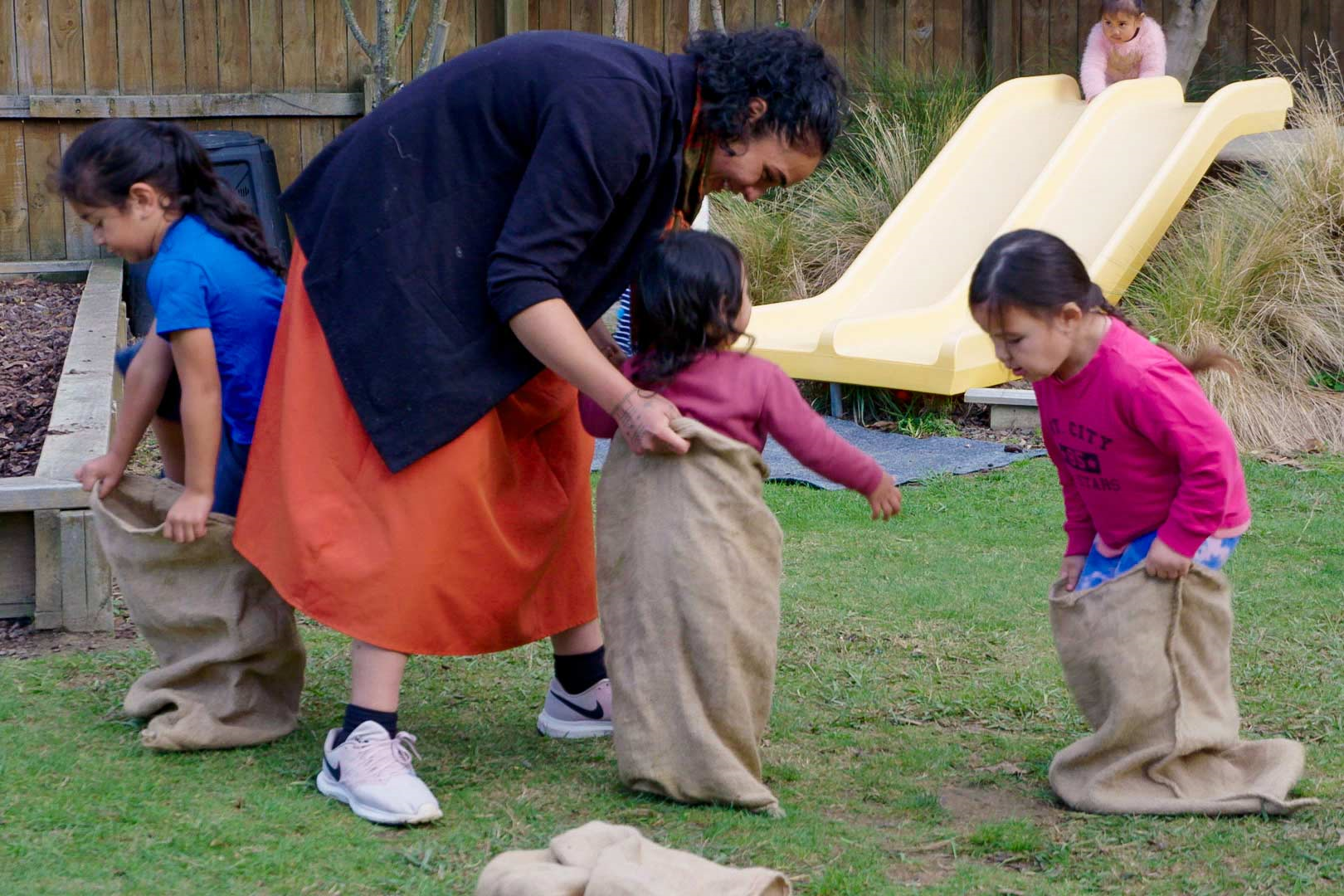
It is never long before one game or another starts, gradually engaging tamariki of all ages. There are small sacks out for use. Tuuga taga, sack racing, is a game from Samoa where copra sacks are plentiful. A tamaiti climbs into the sack and starts jumping, then another, and another. A faia'oga, teacher, will join them and support the emerging sack races. As tamariki compete they perfect their jumping skills. Soon there is a group of tamariki watching and waiting for their turn. Physical play is often a collective experience here.
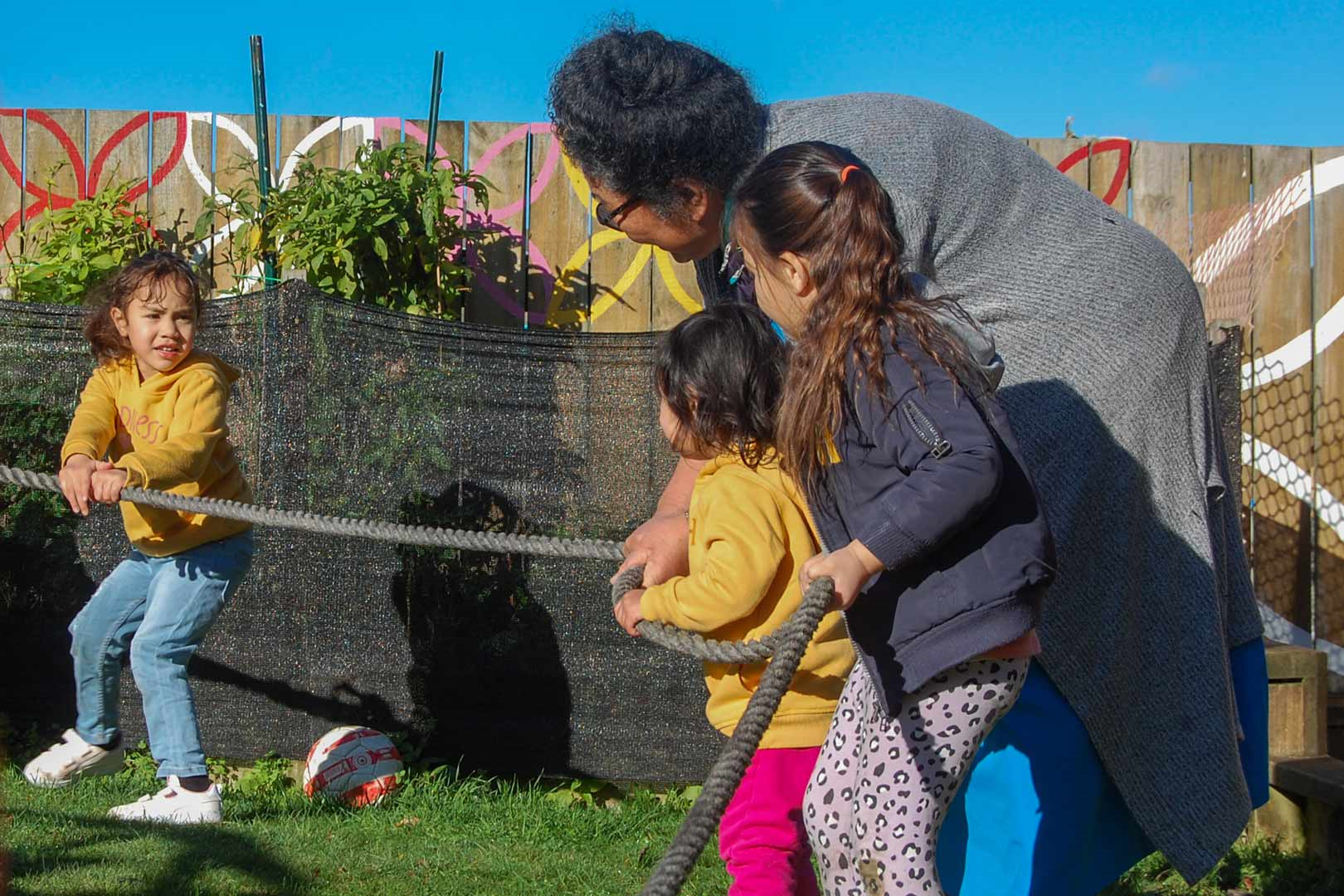
The centre plays many of the traditional village games common in Samoa such as tosogā maea, tug of war. Tosogā maea is often played competitively; the largest person is valued as the anchor, while smaller people are at the front leading their team to pull. Everyone in the team is valued for their different strengths. Faia'oga support tamariki as they experience the feeling of being a winner or loser, and enhance the sense of being part of a team.
Tafue, skipping, is another Samoan game played. Tamariki challenge themselves to skip for as long as they can without touching the large rope. Younger tamariki are persistent in their efforts to get as good as the older tamariki.
When there are games, there is a sense of excitement in the air. This is also true for indoor games. These are often accompanied with songs such as Ooe Isumu, Tule Tule I, or Po Po Manoō. Many of these games require fine motor movements such as pointing or tickling.
Faia'oga have observed that along with learning the games of Samoa, children also:
- gain increased physical health and wellbeing
- develop their fundamental movement skills
- grow their sense of confidence and competence
- experience and understand being a team player
- experience and understand being a winner or loser
- support others and receive support from others
- understand and follow rules.
Tamariki setting their own physical challenges in the natural environment
Key points:
- Supporting the development of fundamental movement skills in natural environments
- Using community spaces to provide different learning environments
Working in a home-based setting, the visiting teacher’s focus is supporting home educators to enhance children's learning. The visiting teachers at Creators@home have been encouraging home educators to use community spaces such as playgrounds, bush areas, and gardens to build on the learning experiences in the home outdoor environment.
Visiting teachers often accompany home educators and tamariki on excursions to promote the learning opportunities that can be found in these environments. This story describes a memorable visit to the botanical gardens with a home educator and the four children in her care.
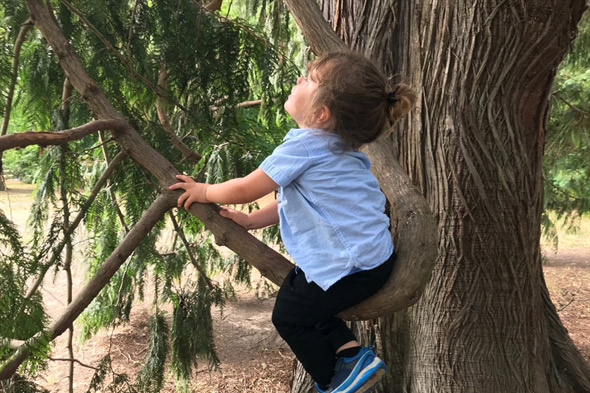
Neihana’s response to the gardens highlighted his interest in tree climbing. The large flat logs caught his eye first. He climbed up and jumped off them time and time again as he perfected his landings. After lunch there was a new group of trees to explore. The adults followed Neihana's lead. When they got there Neihana asked for help to get up into one of them. He gripped the branch with his legs for balance as he turned around to survey his surroundings.

Back on the ground, Neihana found one of the biggest trees with the most enormous trunk. He started to climb, but soon slipped back down. He tried again without much more success. Again and again he tried. Each time Neihana slipped down the trunk, he would start again, getting a little higher up the tree with each attempt. Another child joined Neihana in his goal to climb the tree and he encouraged them on.
Neihana's growing sense of māiatanga1 (confidence, self-reliance, leadership, perseverance, and self-assurance) was evident. Taking time to ensure Neihana could explore the challenge he had set himself, the visiting teacher and home educator also noted that Neihana:
- set his own physical challenges
- developed stability skills and gross locomotor movements such as jumping, climbing, and running
- was a brave learner like Māui-tikitiki
- demonstrated determination and persistence in achieving his goals
- demonstrated leadership qualities in leading the way and supporting others
- expressed his enjoyment in the natural environment.
Mauri Tū, Mauri Ora! – An active soul is a healthy soul
These cards support professional discussions about oranga tinana (the physical wellbeing) of tamariki. We suggest you read the cards and choose questions that resonate with your service.
See Materials that come with this resource to download Printable Kia kori tahi provocation cards (.pdf). The text is positioned so the printed pages can be folded in half.
Posters provide visual reminders for kaiako and tamariki about physical wellbeing. Kaiako can also use them to talk with tamariki about their physical activity and nutrition.
See Materials that come with this resource to download:
- Waiho i te toipoto, kaua i te toiroa, Let us keep close together, not far apart (.pdf)
- Ka kori ana ahau ka mārama haere ahau ki taku tinana, When I move, I learn about my body (.pdf)
- Ka kai ana ahau ka ora taku tinana, taku mauri me taku hinengaro, When I eat, I nourish my body, my soul, my mind (.pdf)
Kaiako can use these freely available online resources to learn about oranga tinana (the physical wellbeing) of tamariki and to find activities they could use with tamariki.
See Materials that come with this resource to download:
- Kia kori tahi: Key resources curated list (.pdf)
Reference
Te Whatu Pōkeka: Kaupapa Assessment for Learning Māori: Early Childhood Exemplars, Te Tāhuhu o te Mātauranga Ministry of Education.
Kua kite rānei koe?
About this resource
Kia kori tahi is a suite of resources designed to support the physical wellbeing of tamariki, with a focus on active movement. They support kaiako to consider the ways in which they currently support the physical wellbeing of tamariki and how that learning is occurring. Kia kori tahi resources are aligned to the concepts and approaches that underpin He Māpuna te Tamaiti suite of resources.






